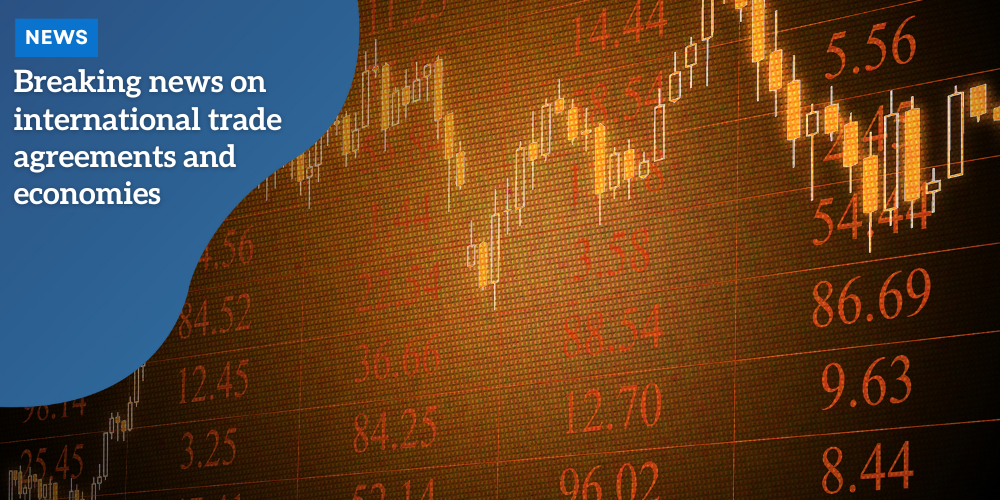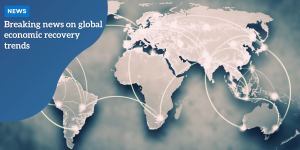Breaking news on international trade agreements and economies

Anúncios
Breaking news on international trade agreements highlights their evolving nature, with a focus on digital trade, regional partnerships, and sustainability, significantly impacting economies and businesses worldwide.
Breaking news on international trade agreements is reshaping the landscape for countries around the world. Have you ever wondered how these shifts can impact your business? Stay with us as we unpack the current dynamics and their implications.
Current trends in international trade agreements
Understanding the current trends in international trade agreements is crucial for businesses and policymakers. As countries engage in negotiations, various patterns and practices emerge that can significantly impact global markets.
Anúncios
One noticeable trend is the rise of regional trade agreements. Countries are forming coalitions to reduce tariffs and streamline regulations. These agreements can facilitate smoother transactions and foster economic cooperation.
Shifts Towards Digital Trade
Another important aspect to consider is the focus on digital trade. With the growth of e-commerce, many agreements are expanding to include provisions that address data flow, cybersecurity, and intellectual property in the digital realm.
This shift acknowledges the importance of technology in global commerce. Countries are investing in infrastructure to support digital transactions, and agreements are evolving to create standards that safeguard businesses and consumers alike.
Emphasis on Sustainability
Moreover, there’s a growing emphasis on sustainability within trade agreements. As climate change becomes a pressing issue, many nations are integrating environmental considerations into their trade policies.
- Regulations to reduce carbon footprints
- Standards for sustainable sourcing of materials
- Incentives for businesses that adopt eco-friendly practices
This is pushing businesses to adapt and innovate in how they operate globally. Countries recognize that environmental health is directly linked to economic viability.
Anúncios
Finally, the uncertainty surrounding international relations often influences trade agreements. Countries may reassess their partnerships in response to geopolitical events. As tensions rise or wane, trade agreements can be renegotiated or abandoned altogether.
Keeping an eye on these current trends is essential for anyone involved in international trade. Adapting to these changes can provide significant opportunities for growth.
Impact of trade agreements on local economies
The impact of trade agreements on local economies is significant and multi-faceted. As countries enter into these agreements, they can reshape the economic landscape of communities and regions. One of the most immediate effects is the potential for increased job creation in industries that benefit from reduced tariffs and better access to foreign markets.
However, this growth is not uniformly distributed. Certain sectors may thrive, while others face challenges from increased competition. This shift can lead to both the creation and loss of jobs, depending on local industry strengths.
Job Creation and Economic Growth
Trade agreements can stimulate economic growth, particularly in areas like manufacturing and agriculture. When barriers are lowered, companies can export more goods. This creates demand for labor and can lead to higher wages.
- Increased exports boost local production.
- Expansion of small businesses that can access bigger markets.
- Potential for attracting foreign investment.
As businesses grow, local economies benefit from increased spending, which helps support jobs in other sectors like retail and services.
Challenges for Local Businesses
On the flip side, some local businesses may struggle to compete. Imports from countries with lower production costs can flood the market. This can force smaller companies to either innovate or close their doors.
The impact on local economies truly varies by industry and geography. Regions dependent on specific sectors might find themselves in a vulnerable position during economic shifts driven by international trade. Understanding these dynamics is crucial for communities to adapt and respond effectively.
Moreover, trade agreements often incorporate different regulations that can affect local industries. These can include labor standards or environmental guidelines that might not align with existing local practices, imposing additional costs on businesses.

Challenges faced in negotiating trade deals
The challenges faced in negotiating trade deals can be complex and multifaceted. As countries come together to discuss terms, they often encounter a variety of obstacles that can complicate agreements. One major challenge is balancing the interests of different stakeholders, including businesses, governments, and consumers.
Each party has its own priorities, which can sometimes clash during negotiations. For example, businesses may prioritize lower tariffs, while governments might be focused on protecting local jobs.
Economic Factors
Economic conditions play a crucial role in trade negotiations. Countries dealing with economic downturns may be less willing to make concessions, fearing backlash from their populations. The pressure to secure favorable terms can lead to tough stances that prolong discussions.
- Exchange rate fluctuations can affect trade terms.
- Inflation rates may impact purchasing power.
- Overall economic stability influences negotiation strategies.
Moreover, unexpected economic events, like a recession or a natural disaster, can derail ongoing negotiations. Countries must remain flexible and adapt their strategies accordingly, which can be a significant challenge during protracted discussions.
Political Considerations
Political climate also influences trade negotiations. Changing administrations or political turmoil can create uncertainty. Leaders may change their positions based on public opinion, impacting previously agreed-upon terms.
The rise of protectionism in various countries adds another layer of difficulty. Growing sentiments against globalization can lead to more rigid negotiating conditions. This environment can make it challenging to achieve agreements that benefit all parties involved.
Additionally, cultural differences can pose challenges. Different countries may approach negotiations with varied expectations and communication styles. Understanding these nuances is key to progressing successfully in trade discussions.
Future outlook for international trade agreements
The future outlook for international trade agreements is shaped by numerous evolving factors. As technology advances and global relationships change, trade agreements are likely to adapt to meet new challenges and opportunities. One major aspect of this future involves the integration of technology into trade processes.
Countries are increasingly recognizing the importance of digital trade. This includes ensuring that digital goods and services flow freely across borders. As more businesses move online, new trade agreements will likely address issues such as data privacy, cybersecurity, and cross-border data flows.
Shifts Towards Regional Trade Agreements
We may also see a shift towards more regional trade agreements. These agreements involve neighboring countries coming together to create trade pacts that simplify transactions. By focusing on regional alliances, nations can strengthen economic ties and address specific local issues effectively.
- Regional agreements can be faster to negotiate.
- They allow countries to collaborate on shared challenges.
- Common standards can boost trade efficiency.
This trend might help countries mitigate the uncertainties in global trade by relying on stronger regional partnerships.
Increased Focus on Sustainability
Another critical element is sustainability. With growing awareness of climate change, future trade agreements may include more stringent environmental standards. Nations will likely collaborate to promote sustainable practices among trading partners.
This could mean integrating guidelines that promote renewable resources and reduce carbon footprints. Such approaches are becoming essential as countries aim to align their trade practices with global environmental goals.
Overall, the future of international trade agreements will likely be influenced by global events, technological advancements, and changing consumer preferences. Staying adaptable and informed will be key for businesses and governments navigating this dynamic landscape.
FAQ – Frequently Asked Questions about International Trade Agreements
What are international trade agreements?
International trade agreements are contracts between countries to facilitate trade by reducing tariffs and other barriers to trade.
How do trade agreements affect local economies?
Trade agreements can boost local economies by increasing exports and creating jobs, but they can also lead to challenges for local businesses facing competition.
What challenges do countries face in negotiating trade deals?
Countries face challenges such as balancing stakeholder interests, adapting to economic conditions, and handling political pressures during negotiations.
What is the future outlook for trade agreements?
The future will likely focus on digital trade, regional partnerships, and sustainability while adapting to changing global dynamics.






